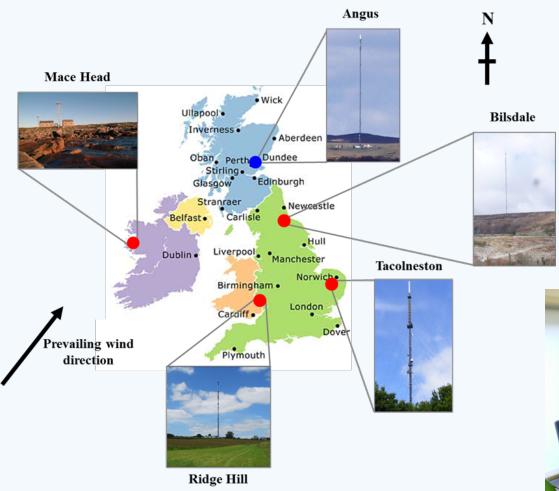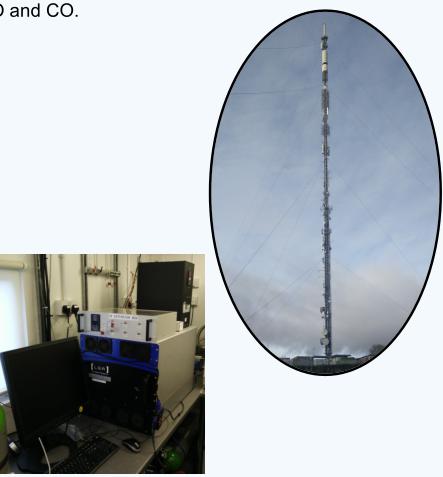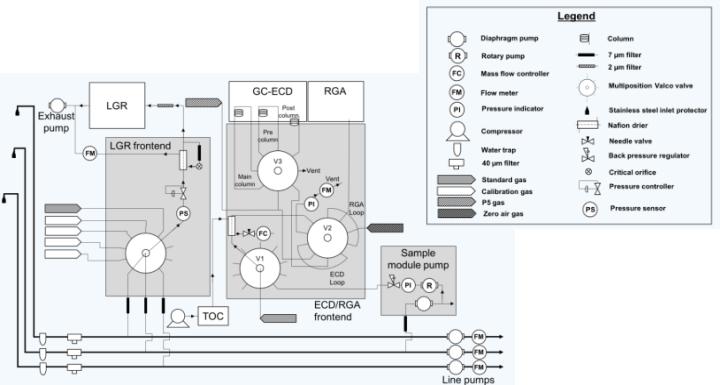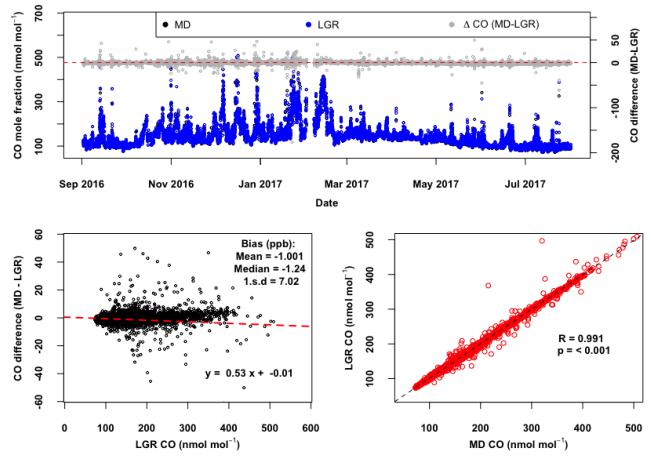1 Introduction
• Since the start of 2012 for the first time atmospheric N 2 O and CO mole fraction measurements of emissions associated with climate change in Britain derived (DECC).
• Used to better understand regional pollution events, calculate UK emissions and combine trace gas with counter models and verify the impact of the UK emissions inventory on Kyoto baskets.
• Historically, gas chromatography for N 2 O and CO measurements
Electron capture detector ( GC-ECD) and reducing gas analyzer (RGA).
• Older measurement techniques provide high frequency, high quality data; however,
This failed to reach the World Meteorological Organization Global Atmosphere Watch ( WMO / GAW)
The recommended N 2 O interlaboratory comparability target is ±0.1 ppb.
• In addition, the sporadic and short-time resolution of N 2 O contamination events captured by the 10-minute sampling frequency of GC-ECD and RGA may not be complete.
• New optical instruments available on the market today can collect data more accurately and quickly than previous systems.
• Lebegue et al. ( 2016) previously compared N 2 O measurements with optical instruments under laboratory conditions; however, this study compared measurements performed under laboratory conditions for a number of instruments.
• The sampling conditions of the far sampling area are usually different from the sampling conditions of the laboratory; therefore, the required position information of the remote field measurement sampling is further compared.
2. Field location
• The Tarcorston Tower (Norfolk, UK, Figure 1) is located in the eastern part of the UK and belongs to the UK DECC network system .
• The site has been in operation since 2012 and continuously measures over 50 greenhouse gases and ozone depleting substances, including N 2 O and CO.

Figure 1. Location of the UK DECC monitoring station . All UK monitoring stations are located in the telecommunications tower. The red dot represents the current DECC monitoring station and the blue dot represents the former UK DECC monitoring station .

Figure 2. The LGR instrument is installed in the Tacolneston tower.
3. Instrumentation
• Since 2012, Tacolneston has measured N 2 O and CO using GC-ECD (Agilent 6890 GC) and RGA (PP1, Peak Laboratories).
• In September 2016, an off-axis integrated cavity output spectrometer (OA-ICOS was installed in Tacolneston; with the Los Gatos Research EP30 N 2 O modified by the Scripps Institution of Oceanography / CO Analyzer) (Figure 2).
4. Experiment
• Sample air from 54, 100 and 185 magl at ~ 20 L min -1.
• Both instruments sample the secondary line of the branch through a custom front-end system (Figure 3).
• Instruments calibrated using WMO standard calibrated standards (N 2 O WMO x2006A and CO WMO x2014A).
• Use a calibration gas to correct the nonlinear data of the instrument.
• Use only the same entry data as the GC
•09/2016 - 03/2017:100 magl
Figure 3: Schematic diagram of the Tacolneston experimental setup.
 |
•03/2017 - 08/2017: 185 magl
• Data matches in a one minute matrix.
5. Results
• Table 1 shows the instrument accuracy during the test.

LGC and GC-ECD / RGA (MD) accuracy (1σ) for repeated injection of standard gas from September 1, 2016 to August 1, 2017
• LGR and GC-ECD / RGA compatibility for N 2 O as shown in Figure 4, for CO as shown in Figure 5.

Figure 4. N 2 O compatibility results from September 1, 2016 to August 1, 2017: a) Time series of LGR and GC-ECD N 2 O values, b) N 2 O difference between instruments , and c) the correlation between instrument reported values.

Figure 5. CO compatibility results from September 1, 2016 to August 1, 2017: a) time series of LGR and GC-ECD CO values, b) CO differences between instruments, and c) instrument reports The correlation between values.
6 Conclusion
• Use GC-ECD / RGA to measure atmospheric CO and N 2 O in the Tacolneston tower since 2012.
• The LAC CO / N 2 O analyzer was installed in Tacolneston in September 2016 and runs in parallel with GC-ECD / RGA
• LGR is more accurate for both CO and N 2 O measurements.
• In-situ instrument compatibility shows average deviation:
• N 2 O: 0.298 nmol mol -1 (more than ±0.1 nmol mol -1 for WMO compatibility guidelines).
• CO: -1.001 nmol mol -1 (WMO compatibility guide is ±2 nmol mol -1).
• More investigations are needed on the nonlinear correction of LGR and GC-ECD / RGA.
Black sesame oil
1)All natural
2)Quality guaranteed since 2000.
3)Made from 100% premium roasted Chinese sesame seeds.
4)Traditional stone grinding process
5)No artificial colouring and no flavour.
6)Cholesterol free.
Black Sesame Oil,Pure Black Sesame Seed Oil,100% Purity Sesame Oil,Super Grade Black Sesame Seeds Oil
Chinese Seasoning (Shandong) Trading Co.,Ltd , https://www.zt-trading.com